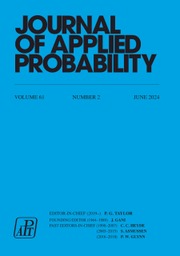No CrossRef data available.
Article contents
Inverse clustering of Gibbs partitions via independent fragmentation and dual dependent coagulation operators
Published online by Cambridge University Press: 30 July 2025
Abstract
Exchangeable partitions of the integers and their corresponding mass partitions on  $\mathcal{P}_{\infty} = \{\mathbf{s} = (s_{1},s_{2},\ldots)\colon s_{1} \geq s_{2} \geq \cdots \geq 0$ and
$\mathcal{P}_{\infty} = \{\mathbf{s} = (s_{1},s_{2},\ldots)\colon s_{1} \geq s_{2} \geq \cdots \geq 0$ and  $\sum_{k=1}^{\infty}s_{k} = 1\}$ play a vital role in combinatorial stochastic processes and their applications. In this work, we continue our focus on the class of Gibbs partitions of the integers and the corresponding stable Poisson–Kingman-distributed mass partitions generated by the normalized jumps of a stable subordinator with an index
$\sum_{k=1}^{\infty}s_{k} = 1\}$ play a vital role in combinatorial stochastic processes and their applications. In this work, we continue our focus on the class of Gibbs partitions of the integers and the corresponding stable Poisson–Kingman-distributed mass partitions generated by the normalized jumps of a stable subordinator with an index  $\alpha \in (0,1)$, subject to further mixing. This remarkable class of infinitely exchangeable random partitions is characterized by probabilities that have Gibbs (product) form. These partitions have practical applications in combinatorial stochastic processes, random tree/graph growth models, and Bayesian statistics. The most notable class consists of random partitions generated from the two-parameter Poisson–Dirichlet distribution
$\alpha \in (0,1)$, subject to further mixing. This remarkable class of infinitely exchangeable random partitions is characterized by probabilities that have Gibbs (product) form. These partitions have practical applications in combinatorial stochastic processes, random tree/graph growth models, and Bayesian statistics. The most notable class consists of random partitions generated from the two-parameter Poisson–Dirichlet distribution  $\mathrm{PD}(\alpha,\theta)$. While the utility of Gibbs partitions is recognized, there is limited understanding of the broader class. Here, as a continuation of our work, we address this gap by extending the dual coagulation/fragmentation results of Pitman (1999), developed for the Poisson–Dirichlet family, to all Gibbs models and their corresponding Poisson–Kingman mass partitions, creating nested families of Gibbs partitions and mass partitions. We focus primarily on fragmentation operations, identifying which classes correspond to these operations and providing significant calculations for the resulting Gibbs partitions. Furthermore, for completion, we provide definitive results for dual coagulation operations using dependent processes. We demonstrate the applicability of our results by establishing new findings for Brownian excursion partitions, Mittag-Leffler, and size-biased generalized gamma models.
$\mathrm{PD}(\alpha,\theta)$. While the utility of Gibbs partitions is recognized, there is limited understanding of the broader class. Here, as a continuation of our work, we address this gap by extending the dual coagulation/fragmentation results of Pitman (1999), developed for the Poisson–Dirichlet family, to all Gibbs models and their corresponding Poisson–Kingman mass partitions, creating nested families of Gibbs partitions and mass partitions. We focus primarily on fragmentation operations, identifying which classes correspond to these operations and providing significant calculations for the resulting Gibbs partitions. Furthermore, for completion, we provide definitive results for dual coagulation operations using dependent processes. We demonstrate the applicability of our results by establishing new findings for Brownian excursion partitions, Mittag-Leffler, and size-biased generalized gamma models.
Keywords
MSC classification
Information
- Type
- Original Article
- Information
- Copyright
- © The Author(s), 2025. Published by Cambridge University Press on behalf of Applied Probability Trust


